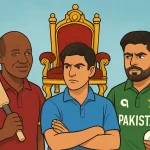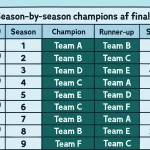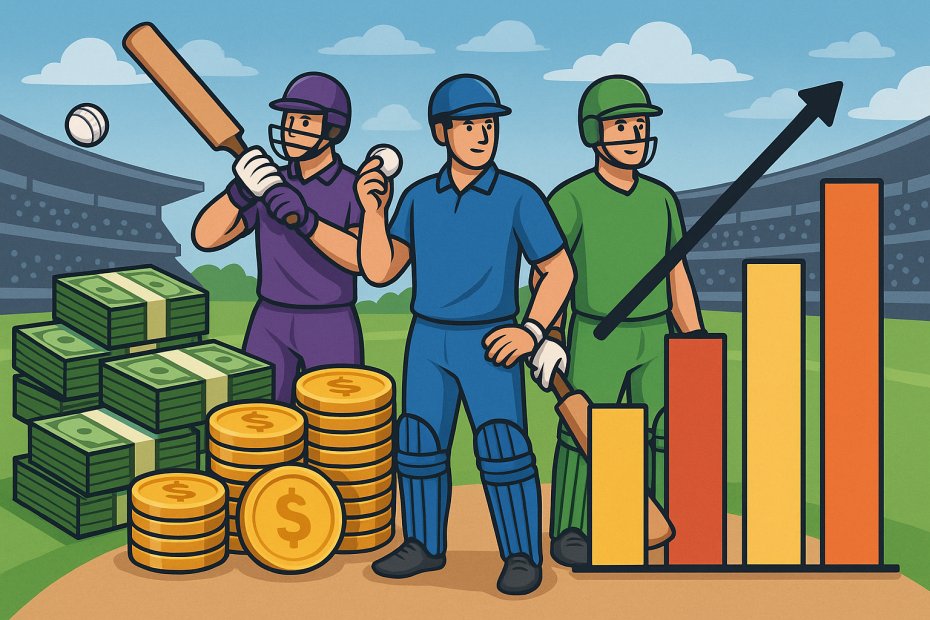It’s one thing to see fireworks on the field. It’s another to understand the numbers igniting those sparks behind the scenes. Every reverse sweep, yorker, and last-ball finish in modern T20 cricket carries more than just emotional weight — it carries financial consequence. And as someone who’s been in dugouts, sat through full-team strategy meetings, and spoken with franchise owners over iced tea and spreadsheets, I can assure you: the game has changed.
In this detailed, no-fluff breakdown, we’re peeling back the curtain on the richest cricket leagues in the world — where money meets flair, commerce meets competition, and team owners, broadcasters, and global fans are all chasing the same thing: returns, relevance, and ratings.
Forget just googling top cricket leagues by revenue — this guide is a battlefield report, blending financial data with lived experience. Here’s how the big leagues really stack up.
⚡ The Power Shift: How Cricket Leagues Became Mega-Economies
Walk into a dressing room during a T20 franchise season, and you’ll feel the shift. Physio tables packed, video analysts multitasking on split-screen monitors, foreign coaches talking ‘matchups’ with local legends. This is not old-school cricket anymore. It’s a multi-million-dollar machine — precise, aggressive, and ruthlessly optimized for entertainment and revenue.
The economic acceleration of cricket leagues didn’t happen overnight. It was engineered — through:
- Broadcasting rights wars
- Sponsorship bidding frenzies
- A global calendar tailored for T20s
- Superstar auctions attracting talent across borders
Now, let’s get into the list — not just ranked by revenue, but unpacked with real insights into what makes these leagues the financial juggernauts they are.
🏆 1. Indian Premier League (IPL)
Keyword Focus: Richest cricket league in the world, most valuable cricket leagues, highest paying cricket leagues
| Factor | Details |
|---|---|
| Brand Valuation | Over $10 billion |
| Broadcasting Rights | Sold for more than $6 billion over 5 years |
| Sponsorship | Title sponsors pay over $60 million annually |
| Player Salaries | Top players earn over $2 million/season |
| Teams | 10 |
Let’s not pretend: The IPL is in a league of its own.
This is not a cricket tournament — it’s India’s version of the Super Bowl crossed with Hollywood drama. In one edition, more money flows through the IPL media rights than the GDP of some cricketing nations.
Inside the dressing room? Everything is dialed to maximum. Dedicated spin coaches, nutritionists, tactical scouts, and brand teams. You sign autographed jerseys before heading out to warm-up. Player management firms negotiate clauses for post-match Instagram reels. It’s wild.
The mega-deals behind the scenes include:
- Star Sports’ record-breaking media rights deal — over $6 billion
- JioCinema’s entry into OTT — streaming in multiple languages, disrupting viewer patterns
- Massive title sponsor contracts: From Vivo to Tata, every brand wants a chunk
The IPL isn’t just the world’s richest cricket league — it’s the world’s most watched domestic league outside football. From Ben Stokes to Rashid Khan, everyone’s chasing an IPL contract not just for the prestige, but the paycheck.
Why it’s #1: Sheer scale, financial sophistication, superstar density, and unmatched audience reach.
💡 Behind the Numbers: What Makes the IPL a Monster?
Let’s break down player earnings. A domestic uncapped player in India could earn up to ₹8 crore playing in the IPL — more than what they earn in their entire Ranji Trophy career.
For a global superstar like Jos Buttler or Pat Cummins, the paycheck often includes:
- Auction Fee
- Performance Bonuses
- Endorsement Opportunities
- Merchandise Revenue %
Add to that primetime visibility and a fanbase built overnight.
🌍 2. Big Bash League (BBL)
Keyword Focus: IPL vs BBL revenue comparison, top T20 leagues by revenue
| Factor | Details |
|---|---|
| Brand Valuation | ~$500 million |
| Broadcasting Rights | Approx. $1 billion (multi-year deal) |
| Teams | 8 |
| Title Sponsors | Multiple corporate partners — KFC, Toyota, etc. |
Australia’s BBL was once touted as the ‘family-friendly’ T20 league. But make no mistake — behind those mascots and beach balls in the stands lies serious cash.
Cricket Australia structured BBL on a franchising model — not privately owned like IPL but centrally controlled. While this capped the commercial chaos, it also ensured revenue sharing was equitable and sustainable.
The real power of the BBL lies in:
- Local Stars: Big Bash made players like Glenn Maxwell household names
- Prime-Time Timing: Played during Aussie holiday season = full stadiums
- Stadium Deals: Marvel and SCG rake in money through branding partnerships
Why it’s #2: While not on IPL’s scale, it’s the strongest cricket league financially outside India. Controlled costs, quality cricket, and a loyal base make it reliable.
🕌 3. Pakistan Super League (PSL)
Keyword Focus: financially strong cricket leagues, cricket leagues with highest player salaries
| Factor | Details |
|---|---|
| Brand Valuation | ~$300 million |
| Player Salaries | $130,000+ for top drafts |
| Broadcasting Rights | Millions annually; demand growing fast |
| Teams | 6 |
The PSL often gets pigeonholed by geopolitical noise — but insiders know it’s one of the most tightly organized and cash-efficient leagues globally.
Here’s why it punches above its weight:
- Massive diaspora interest: From London to Dubai, PSL streaming numbers are in the millions
- Talent concentration: Deep local talent pool keeps wage inflation low while product quality is high
- Smart logistics: Running shorter seasons with fewer teams helps manage costs
Franchise valuations are soaring. What started as a risk has become Pakistan’s most followed sports product globally.
Why it matters: PSL might not write the largest cheques. But as a commercial enterprise built in challenging conditions, it’s a remarkable financial success story.
🏙️ 4. SA20 League (South Africa)
Keyword Focus: emerging cricket leagues worldwide, richest leagues in cricket history
| Factor | Details |
|---|---|
| Key Sponsor | Betway, SuperSport |
| IPL Ownership Involvement | 5 of 6 franchises owned by IPL franchises |
| Revenue Impact | Revived CSA’s financial stability |
| Player Salaries | Mid-level international rate + match-winning bonuses |
SA20 is the comeback story no one saw coming.
Following years of cricketing chaos in South Africa — from financial mismanagement to administrative collapse — SA20 emerged as an IPL-backed, media-driven juggernaut.
The major breakthrough? Almost all teams are owned by IPL franchises (MI Cape Town, Pretoria Capitals, etc). That means synergy — in player recruitment, branding, operations.
Players have told me SA20 contracts are “cleaner and quicker” — fewer delays, better facilities, and solid exposure.
Viewership, too, has spiked. For CSA, this league is now their lifeboat.
🏰 5. The Hundred (England)
Keyword Focus: most popular domestic cricket leagues
| Format | Details |
|---|---|
| Format | 100 balls, original to ECB |
| Teams | 8 men, 8 women |
| Players | Combined drafts |
| Revenue Streams | BBC/Broadcast, Ticketing, Merchandise |
A polarizing league — but economically calculated.
The ECB took a gamble with The Hundred, launching a completely redesigned format. The purists scoffed. Younger fans tuned in. Sponsors showed up.
While it doesn’t match IPL-level finances, major brands like KP Snacks, BBC, BBC Sport, Sky Sports gave the league commercial legs.
More importantly, it created a dual-gender cricket economy. Equal prizes, equal TV time — a financial leap other leagues hadn’t taken.
Economics Note: Centralized structure = controlled spend.
🌓 Honorable Mentions: Under-the-Radar Riches
Caribbean Premier League (CPL)
- Strong local flair + Bollywood investment + US stadiums
- Profitable despite low bids, thanks to low player cost and high viewership in diaspora
Lanka Premier League (LPL)
- Backed by Indian capital, seeing slow growth
- Needs domestic economic support to scale further
UAE ILT20
- Offers player salaries competitive to even PSL
- What it lacks in tradition, it offsets with cash
🧾 Player Salaries Compared by League
| League | Top Salary Range (USD) | Notes |
|---|---|---|
| IPL | $2 million+ | Auction model, brand bonuses |
| BBL | $250,000-$350,000 | Central contracts influence earnings |
| PSL | $130,000-$180,000 | Draft system, performance-based |
| SA20 | $125,000-$200,000 | Many IPL franchises offer loyalty bonuses |
| ILT20 | ~$450,000 | Funded by Emirates Cricket; newer league |
| CPL | $100,000 max | Cost-efficient operations |
💰 How Do T20 Leagues Make Money?
- Broadcasting Rights: Up to 60% of revenue
- Central Sponsorships: League deals (naming rights, branding, beverage sponsors)
- Franchise Fees: Owners pay annually to retain license
- Stadium Revenue: Tickets, VIP boxes
- Merchandise: Team kits, mascots, collectibles
- Digital Monetization: YouTube ads, player features, fantasy cricket
🔮 The Future: Will Any League Challenge the IPL?
Not in the near term. However:
- SA20 is positioned uniquely due to IPL club ownership. That vertical integration could create the first full-year global calendar for certain players.
- ILT20 may overwhelm with paychecks but still lacks gravitas.
To match IPL, a league would need:
- A billion+ viewership base
- Robust sponsorship ecosystem
- The pull of local mega-stars
- Political and infrastructure stability
Right now, only one flag flies there.
🔁 Key Takeaways
- IPL is by far the richest cricket league — bigger than many global sports tournaments
- BBL and PSL follow as stable, well-managed, revenue-generating products
- Newcomers like SA20 and ILT20 are shaking up the player market with new cash
- Player salaries vary widely — influenced by league ownership models and demand cycles
- Global expansion is real — from USA to UAE, new leagues are testing old models
📝 Conclusion: The Economics of Cricket Have Forever Changed
The bat no longer does all the talking. Spread across sponsorship decks, media rights contracts, merchandising plans, and digital engagement dashboards — cricket has evolved into an economic behemoth.
From IPL’s billion-dollar seasons to PSL’s financial ballet, from BBL’s loyal fanfare to SA20’s revitalizing shot in the arm — T20 leagues are no longer just side shows; they are the main event.
If you want to understand where cricket goes next, follow the money. It’s leading us to newer pitches, deeper pockets, and fresher rivalries that aren’t just about national pride, but market share.
Welcome to the age of cricket capitalism. And we’ve only just begun.
FAQs
- Q: Which is the richest cricket league in the world?
- A: The Indian Premier League (IPL) is the undisputed leader in terms of revenue, brand value, broadcasting rights, and player salaries.
- Q: How do cricket leagues make money?
- A: Primarily through broadcasting rights, central sponsorships, franchise fees, ticket sales, merchandise, and digital streaming partnerships.
- Q: Which league pays players the most?
- A: The IPL pays the highest player salaries by far, with top international stars earning $2 million or more per season.
- Q: Are new leagues like SA20 and ILT20 financially strong?
- A: Yes, especially with IPL franchise ownership and Gulf-based funding respectively. They’re creating viable new markets.
- Q: Can any league compete with IPL?
- A: Not currently in terms of scale or money. But leagues like SA20 with strong IPL involvement may grow faster than others.
Article by a cricket writer who’s seen boardroom contracts, changing rooms chaos, and the glare of broadcast deals up close.
Related posts:
Cricket Prince: Who's the Heir — Lara, Gill, or Babar?
T20 Highest Score Guide: Team Totals, Records & Context
Youngest cricketer in India: Complete Guide to Records & Pathways
Psl winners list: Season‑by‑season champions & finals
About vignesh puthur - Official bio, work & contact
How Many Countries Play Cricket? 108 ICC Members (Updated Oct)
Angad Mehra

- Angad Mehra is an avid cricket analyst and sports writer who pays attention to betting patterns and match specifics. Angad has years of experience writing, covering both Indian and international cricket. He explains stats, odds, and strategies in a clear, simple manner that resonates with fans. Readers trust Angad’s articles to keep them ahead of the game whether on or off the field. Off the field, you can find him either tracking live scores ball by ball or debating IPL lineup changes.
Latest entries
 GeneralNovember 1, 2025Cricket Prince: Who’s the Heir — Lara, Gill, or Babar?
GeneralNovember 1, 2025Cricket Prince: Who’s the Heir — Lara, Gill, or Babar? GeneralOctober 31, 2025T20 Highest Score Guide: Team Totals, Records & Context
GeneralOctober 31, 2025T20 Highest Score Guide: Team Totals, Records & Context GeneralOctober 29, 2025Youngest cricketer in India: Complete Guide to Records & Pathways
GeneralOctober 29, 2025Youngest cricketer in India: Complete Guide to Records & Pathways GeneralOctober 27, 2025Psl winners list: Season‑by‑season champions & finals
GeneralOctober 27, 2025Psl winners list: Season‑by‑season champions & finals
